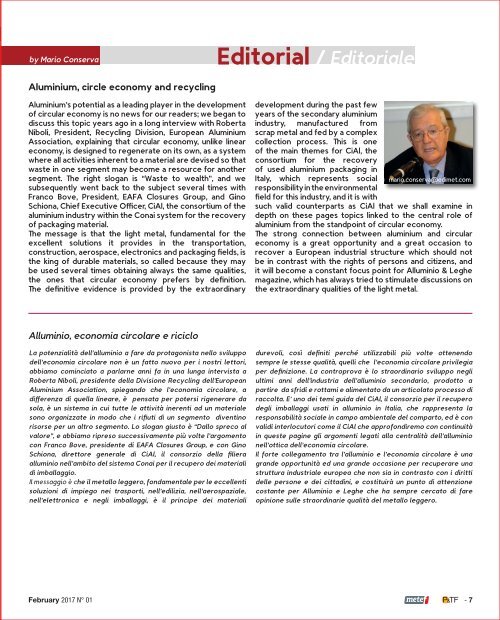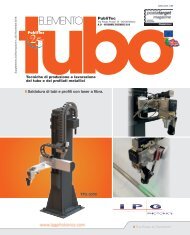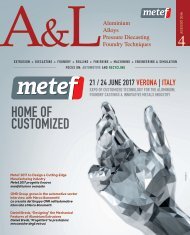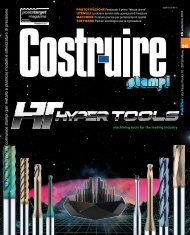sfogliabile_"AL_n1_FEBBRAIO _2017
- No tags were found...
Create successful ePaper yourself
Turn your PDF publications into a flip-book with our unique Google optimized e-Paper software.
0007 1<br />
by Mario Conserva<br />
Editorial / Editoriale<br />
Aluminium, circle economy and recycling<br />
Aluminium’s potential as a leading player in the development<br />
of circular economy is no news for our readers; we began to<br />
discuss this topic years ago in a long interview with Roberta<br />
Niboli, President, Recycling Division, European Aluminium<br />
Association, explaining that circular economy, unlike linear<br />
economy, is designed to regenerate on its own, as a system<br />
where all activities inherent to a material are devised so that<br />
waste in one segment may become a resource for another<br />
segment. The right slogan is “Waste to wealth”, and we<br />
subsequently went back to the subject several times with<br />
Franco Bove, President, EAFA Closures Group, and Gino<br />
Schiona, Chief Executive Officer, CiAl, the consortium of the<br />
aluminium industry within the Conai system for the recovery<br />
of packaging material.<br />
The message is that the light metal, fundamental for the<br />
excellent solutions it provides in the transportation,<br />
construction, aerospace, electronics and packaging fields, is<br />
the king of durable materials, so called because they may<br />
be used several times obtaining always the same qualities,<br />
the ones that circular economy prefers by definition.<br />
The definitive evidence is provided by the extraordinary<br />
development during the past few<br />
years of the secondary aluminium<br />
industry, manufactured from<br />
scrap metal and fed by a complex<br />
collection process. This is one<br />
of the main themes for CiAl, the<br />
consortium for the recovery<br />
of used aluminium packaging in<br />
Italy, which represents social mario.conserva@edimet.com<br />
responsibilityintheenvironmental<br />
field for this industry, and it is with<br />
such valid counterparts as CiAl that we shall examine in<br />
depth on these pages topics linked to the central role of<br />
aluminium from the standpoint of circular economy.<br />
The strong connection between aluminium and circular<br />
economy is a great opportunity and a great occasion to<br />
recover a European industrial structure which should not<br />
be in contrast with the rights of persons and citizens, and<br />
it will become a constant focus point for Alluminio & Leghe<br />
magazine, which has always tried to stimulate discussions on<br />
the extraordinary qualities of the light metal.<br />
Alluminio, economia circolare e riciclo<br />
La potenzialità dell’alluminio a fare da protagonista nello sviluppo<br />
dell’economia circolare non è un fatto nuovo per i nostri lettori,<br />
abbiamo cominciato a parlarne anni fa in una lunga intervista a<br />
Roberta Niboli, presidente della Divisione Recycling dell’European<br />
Aluminium Association, spiegando che l’economia circolare, a<br />
differenza di quella lineare, è pensata per potersi rigenerare da<br />
sola, è un sistema in cui tutte le attività inerenti ad un materiale<br />
sono organizzate in modo che i rifiuti di un segmento diventino<br />
risorse per un altro segmento. Lo slogan giusto è “Dallo spreco al<br />
valore”, e abbiamo ripreso successivamente più volte l’argomento<br />
con Franco Bove, presidente di EAFA Closures Group, e con Gino<br />
Schiona, direttore generale di CiAl, il consorzio della filiera<br />
alluminio nell’ambito del sistema Conai per il recupero dei materiali<br />
di imballaggio.<br />
Il messaggio è che il metallo leggero, fondamentale per le eccellenti<br />
soluzioni di impiego nei trasporti, nell’edilizia, nell’aerospaziale,<br />
nell’elettronica e negli imballaggi, è il principe dei materiali<br />
durevoli, così definiti perché utilizzabili più volte ottenendo<br />
sempre le stesse qualità, quelli che l’economia circolare privilegia<br />
per definizione. La controprova è lo straordinario sviluppo negli<br />
ultimi anni dell’industria dell’alluminio secondario, prodotto a<br />
partire da sfridi e rottami e alimentato da un articolato processo di<br />
raccolta. E’ uno dei temi guida del CiAl, il consorzio per il recupero<br />
degli imballaggi usati in alluminio in Italia, che rappresenta la<br />
responsabilità sociale in campo ambientale del comparto, ed è con<br />
validi interlocutori come il CiAl che approfondiremo con continuità<br />
in queste pagine gli argomenti legati alla centralità dell’alluminio<br />
nell’ottica dell’economia circolare.<br />
Il forte collegamento tra l’alluminio e l’economia circolare è una<br />
grande opportunità ed una grande occasione per recuperare una<br />
struttura industriale europea che non sia in contrasto con i diritti<br />
delle persone e dei cittadini, e costituirà un punto di attenzione<br />
costante per Alluminio e Leghe che ha sempre cercato di fare<br />
opinione sulle straordinarie qualità del metallo leggero.<br />
February <strong>2017</strong> N° 01<br />
- 7





